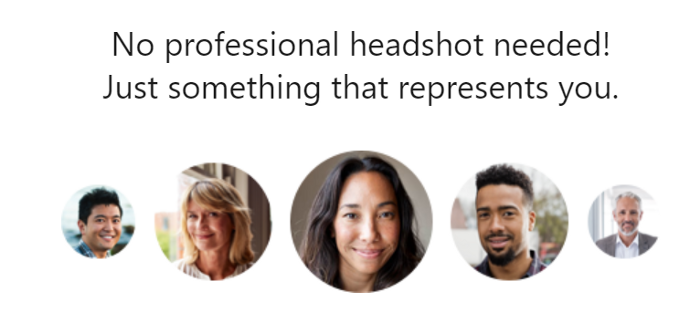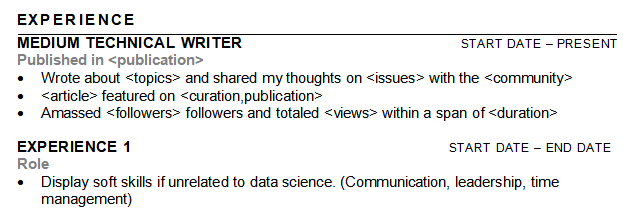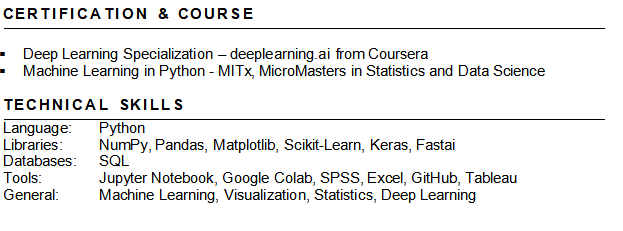This article was published as a part of the Data Science Blogathon.
Simple steps to get you Hired!
The main intention of this post is to help those who are inspired to become a Data Scientist. I will guide you through a few step-by-step process to reach your goal. If you are starting from scratch should be focused and interested to learn new things. Read on, If you like to take this challenge.
Key highlights
- Eager to become a data scientist?
- Your aspired role in Data Science
- Qualification Check
- Enhance your Data Science Skills
- Practice on Projects
- Develop up your Online Presence
- Networking and Linkedin
- Build your resume/CV
- Get selected!
1. Eager to become a data scientist?

The first thought in your mind should be, why a Data Scientist?
The hype around data science is known, but that should not be the only reason you are coming into this field. The fact is, becoming a Data Scientist is no easy task. A Data Scientist requires a knack for looking at data, and it involves lots of experimentation, research, critical and analytical thinking. The analysis often portrays data science as the cool kids next door, working on the best technology like AI but behind every buzzword is hours of hard work and determination.
If you think you have done your fair share of research and decided that the Data Science field is right for you, here is the good news.
The best time to get into this domain is NOW.
Other than the fact that;
- Linkedin reported that Artificial Intelligence Specialist as the #1 Emerging job in 2020,
- World Economic Forum predicted that Data science and related roles created a net 58 million increase in careers in 2022, and
- Glassdoor reported that the median base salary of a Data Scientist is $107,801
Data Science has also grown substantially in recent years, with its potentials recognized by most industries. Areas like healthcare, banking, agriculture, retail, security have already seen their operation influenced by AI, which means that furnishing yourself with data science skills is helpful to your employers, no matter the industry.
Furthermore, training data science has never been simple. The immense interest in data science has led to an explosion in data science resources, benefiting everyone in the field. Blog articles and e-books, a wide variety of instruction materials are publicly available for learners.
So should you become a Data Scientist? If you think of the potential in Data Science, are motivated and driven, I will say go for it.
2. Your aspired role in Data Science
Photo by Isaac Smith on Unsplash
Even though I speculate everything as Data Scientists, but there are multiple roles in Data Science.
- Data Analyst
- Data Scientist
- Machine Learning Engineer
- Business Analyst
- AI Research Scientist, and many more
One of the unique aspects is, you need to learn skills based on the role. A Machine Learning Engineer focuses on the model building and Business Analyst concerns with product details and business knowledge. One can plan a learning journey based on the role. Those with a domain-specific skillset will make you more desirable for many positions.
So before starting learning, search for the role you are interested in pursuing.
3. Qualification Check
One should try to check off these basic skills needed to become a data scientist;
- Probability & Statistics
- Calculus & Linear Algebra
- Programming
- Data Visualisation
- Machine Learning
Many of you will be questioning yourself at this stage and question if your eligibility can build a career in data science. I can, and I will assure you that you definitely can. Apart from the more educational work such as an AI Research Scientist, you do not need a Ph.D. or even a higher degree to shine in data science.
4. Enhance your Data Science skills
Once you think out where to start, it’s time to put that into work. There are typically three ways you can go about studying Data Science.
- Bootcamps
- Graduate Degree (Master or Ph.D.)
- Massive Open Online Courses (MOOCs)
There is no one perfect path, just the one most suitable for you.
Bootcamps
Bootcamps are intensive on-campus training that ranges from a few weeks to a few months. They aim to cover as much content as possible in less duration, where you would expect a very steep learning curve. Time is also a factor as these often require time dedication during the course. This option is recommended only for full-time learners who can commit to their plans.
Least personalized option on this list. Mainly because most boot camps assume zero knowledge and attempt to teach everything from scratch, so there is no need to customize your experience as everyone starts equal.
Here you can connect with like-minded individuals. Other learners will be as inspired as you are, and everyone has a common goal.
Graduate Degree
These are specialized PG programs with a curriculum for the specialization you chose. Some examples are the Master of Science in Data Science from Columbia University and MIT Master of Business Analytics. Furthermore, these programs provide personalization, where you choose the course you wish to pursue. However, stating the obvious here, this is also the most expensive option on this list, and you have to take that into your plan.
Enrolling in a graduate degree program is often a huge responsibility, so make sure you have done your research.
Massive Open Online Courses (MOOCs)
Since it first started, MOOCs have come a long way. Recognized universities are publishing some of their modules as MOOCs, and even major tech companies like Google have come up with their online courses. Using the right resources and the right learning path, anyone can build their armories of data science skills.
No matter which path you decided, leveling up your data science skills is just the first step of becoming a Data Scientist.
5. Practice on Projects
Projects show your ability as a Data Scientist. Projects not only boost your resume but also helps to build up your technical skills.
Kaggle
Kaggle is the best data science competition platform. Competition datasets are often real data provided by companies to solve their business problem. You will go through the whole process of data processing, modeling, evaluation, and optimization, similar to any real-life data science project.
If you are a newbie to Kaggle, competitions are available in several fields. For starters, there are playground or knowledge competitions to compete and win prizes. If possible, work on active featured competitions as placing yourself against the leaderboard is a good experience and a great addition to your resume.
However, the major disadvantage is that datasets from Kaggle are pre-cleaned. Before hosting the competitions in Kaggle, basic pre-processing of data was finished, reducing much of your workload. If you have not heard, Data Scientists typically spend 70% of their time processing data while only 30% on modeling.
Self-initiated Projects
I also suggest you go out there and work on some self-initiated projects. If you know the industry you wish to work in, working on projects relevant to the industry can be a good start. Find available datasets or scrap a website, go through the process of experimentation, and encounter what it is like to be a Data Scientist. One can proudly present their projects to recruiters.
6. Develop your online presence
You need not be an influencer to be a Data Scientist.
Not truly, but alike. Having an online appearance has become increasingly significant in the tech world. For self-learners like us, this helps to verify our work and qualification for Data Science. The followers and comments in the online space is a way to validate the work you did. Nevertheless, this is not any social media followers, this means about people who read your articles, or even a few might get inspired by your concepts and use your projects. The simplest way to build up an online profile is to write your thoughts and share your work.
Medium
You can write and share the articles on the Medium platform, free of cost. You do not need any hosting server or domain name to post your content. Sign up for an account, update your profile, and start writing your thoughts and experience. Medium is one of the best platforms for Data Science articles.
So no idea about what to write? It could be everything or anything helpful. The goal is to write your thoughts, your journey, and many more.
Some blog ideas;
- Share your Data Science learning path with others
- Review courses you practiced
- A brief write-up of your Data Science projects/contests
- Thoughts on Data science
GitHub
You do not belong to the technology sector if you don’t know GitHub. Users upload their open-source codes in the form of a repository (repo) to manage or share their projects. Moreover, It has version control that helps software engineers and data scientists and allows collaboration between experts. Hence, beginning a GitHub account goes a long way to getting noticed in the tech space. Few employers might even ask for your GitHub to assess your projects and codes.
Few things you can do with GitHub?
- Upload projects
- Fork interesting repository
- Commit to another repository
7. Networking and LinkedIn
The best way to network is through LinkedIn. Connecting with people is a great way to share ideas and experiences. Try to attend data science conferences and join your local data science communities. Do not miss out on these carriers of networking. These are great roads to meet new people, gather ideas, and who knows, you might find your next opportunity to work.

Here users can build their professional profiles and connect with people of similar backgrounds. You can find people with similar interests and interact with a personalized message and create a meaningful connection on this platform.
Update your profile with a professional profile picture and a cover image that represent you in LinkedIn. These are the first thing people notice before reading about you, and the first impression is the best one. Update your profile sections with education, certifications, projects, and experience where these are most important. Everyone would be proud of what they had achieved, so display your achievements. Your profile should remain real. Honesty is the best policy. Update your headline to reflect your present status. It might be a current role, education, or general statement about you.
For example,
- Data Analyst in ABC company
- Computer Science Major at Oxford University
- Data Science Enthusiast connecting with Like-minded People
The last step is to make recruiters know that you are open to opportunities in this field. Select the job title and locations in these sections which will be visible to recruiters only. After finishing, head to suggested networks and start connecting.
8. Build your Resume/CV
Finally, you are willing to get a job in Data Science. Or is it?
There is just one last barrier — getting your resume noticed by management. Recruiters receive hundreds of resumes per job opening, so how do you make your resume stand out from the rest.
Profile
Make sure to add your social and online profiles, which allow recruiters to find you easily if they want to.
Projects
We recommend prioritizing your data science projects if you do not have any data science-related experience. This way, it will be kept related to the job scope for whoever reads it.
List down your top three projects beginning from the most impactful. Try to have some variations in your projects to show a wide range of competencies.
For each project;
- Make sure the title is self-explanatory (Eg: Using Twitter’s tweet sentiment to predict prices of NSE)
- Describe the project: Start with describing the project, Tools used, results you had achieved
- Keep it short, concise but show your competency objectively
Experience

The Experience section will come next, list your 2–3 most relevant and recent working experiences. If you do not have any tech experience, your blogging practice would be helpful. It shows your enthusiasm and motivation in the area of data science.
Even if your experience is not related to data science, rephrase it to advertise your soft skills such as communication, leadership, or time management. All of which is as important as your technical skills for a data scientist.
Skills

Be strategic and relevant in this section. Keep it to the most important few, mainly in the ‘Certification & Course‘ section. Unless your certifications are widely recognized, most companies do not care what MOOCs you have taken. Only state those that are popular or from a highly credible university.
As for technical skills, do not list all skills you think you know. Be strategic. Use the company’s Job Description as a reference and write those required for the role.
Make your resume within one page, if not two. Concise is a fundamental aspect, and personalize each resume to the role you are applying before you hit the send button.
9. Get Selected
The media shown in this article are not owned by Analytics Vidhya and is used at the Author’s discretion.






